Each type of freshwater fishing presents its own set of challenges, whether it’s still water such as lakes and ponds; or moving water such as rivers and streams. Each environment has its own ecosystem and structure.
Lakes & Ponds
Fishing in lakes and ponds is a good place to start because they are great places for fish to live. They produce abundant plant food and offer plenty of cover for fish to hide. Learn tips, where to find fish, shoreline structures and more.
LAKE AND PONDS: FISHING TIPS
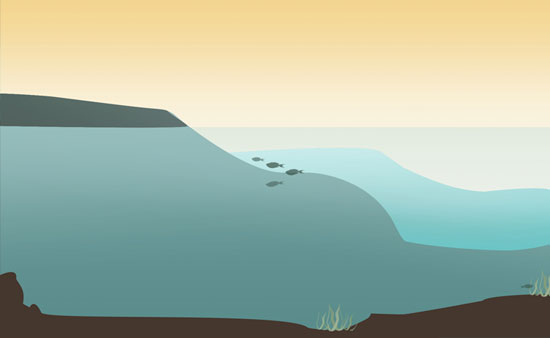
Shoreline structures like docks, logs, stumps, brush and rocks provide shelter, shade and protection for fish. All of which means lakes and ponds are prime fishing spots. You can fish lakes and ponds from the shore or from a boat. You can find fish in shallow or deep water, in open water or near natural or man-made structures. In lakes, you’ll catch freshwater fish species like largemouth and smallmouth bass, pike, pickerel, perch, panfish, trout, even salmon.
Get to know your lake structure. Points, inlets, holes, sunken islands, dams, submerged objects (manmade or natural) and reeds and weeds are all considered structure. You should always fish in and around structure. It's a simple formula.
①Structure creates shallows
②Shallows create plant growth
③Plant growth attracts bait fish
④Bait fish attract game fish, the fish you want to catch
CLIFFS AND STEEP SHORE BANKS


A sheer cliff or bank that goes straight down into deep water provides no structure, break line or gradual path to deeper water. So it doesn't attract fish. On the other hand, a cliff or bank that has an underwater shelf or slopes gradually toward deeper water does attract fish. Look for crumbled-off rock at the underwater base of sharp cliffs. Deep-water fish may be attracted to these rocks for food or spawning.
ROCKS
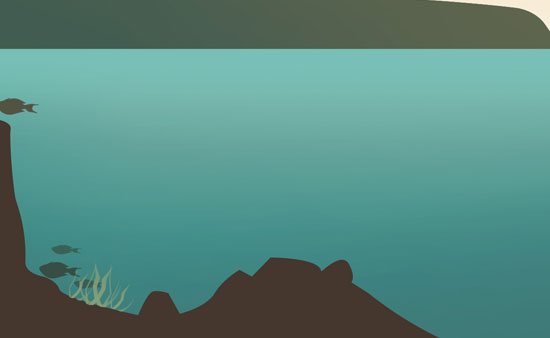
Rocks are often some of the best fishing places. They provide fish with shelter (cover), food and a possible place to mate. Remember, always fish structure. If the rocks are in deeper water or on the edge of deeper water, they provide an even better place for lake and pond fishing. Just be careful not to snag your bait.
LAKE AND POND FISHING POINTS WITH BREAK LINES

A point extends out from the shoreline and slopes gradually down and into deeper water. It is a good place to fish. But a point with a quick drop-off or one that doesn't extend into deeper water isn't a good fishing place.
①The sloping-out formation of a point creates a break line.
②A break line draws fish from deeper water to shallow water in search of food.
③Fish the tip of the point and the corners of the point (the part that curves back into the shore).
DRIFT LINES AND WIND

Have you ever noticed lines on the water during a breezy day? The breeze is actually pushing surface water around the lake which, in turn, pushes surface food around. Look for the drift lines and you'll find fish.
Stronger winds can actually push bait fish closer to shore, bringing game fish closer to shore to feed. Sometimes really strong winds can make for good fishing, stirring up everything from microscopic food to lunker fish. But it's pretty tricky and can be dangerous. So it’s best to go with a pro or experienced guide.
WEED BEDS

Weed beds are structure. They provide food and shelter for bait fish, which attract game fish. Look for weed beds that lead to deeper water and create a break line. Or look for sunken weed beds in deep, open water.
ISLANDS AND SAND BARS

These sunken or partially sunken bodies of land will attract both bait fish and game fish if they create a break line where the land slopes gradually down and into deeper water. Water currents run around islands, too, carrying small plant food and aquatic animals that float on the surface. That can also attract bait fish and game fish.
LAKE AND POND FISHING HOLES

Holes are glacially formed basins that are lower than the rest of the lake. Water in holes is cooler, attracting deep-water fish on hot, summer days. You'll need a topographical map to find them.
OPEN WATER

Good luck. If you're not in shallow water, and there are no weeds or other natural or man-made structure in sight—above or below the water—you're in open water, and you're not in one of the best fishing places.
But you might be right above a stream or river channel that deep-water fish use to go from one side of the lake to the other in search of food. Or, you might be above a deep hole or drop-off where deep-water fish rest from the current. Still, it's tough to catch fish in either of these places.
Sometimes, in early spring and late fall, when there's very little vegetation anywhere, bait fish will roam open lake waters in search of plankton. During those times, you can look for small fish on the surface in the open water. If you see a bunch of small fish, it's a good bet larger fish are lurking below.
SPRING HOLES
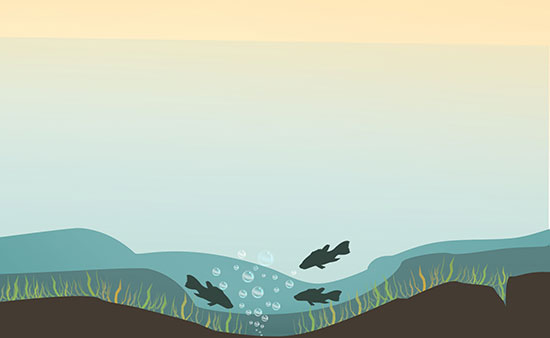
This is one of our favorite freshwater fishing tips. When water boils up from the bottom of the lake, it creates a spring hole. In the summer, deep-water fish are attracted to these holes because the water coming up is always cooler. Even when the hole is not in deep water, spring holes can attract unsuspecting, deep-water lunkers. But spring holes are really tough to find.
If you’re up for the challenge, use a water temperature gauge in the summer to locate the outer edges of the cold water zone and the depth of the layer. Spring holes are sometimes found in boat harbors that have been dredged, which open up springs, causing colder water to collect in areas sheltered from wind. After the water freezes, look for open water along icebound shorelines, which could indicate inflowing springs where the water is warmer in winter than the lake water. Note these areas and return in the summer.
SUNKEN OBJECTS

Trees, branches, logs, stumps and rocks are all considered to be structure. They all provide shelter, shade and protection for fish. So it's a good place to hook a fish. Always watch your line, and be extra careful if you're in a boat so you avoid hitting any objects.
LILY PADS

The insects and other aquatic critters that live on and around lily pads always attract smaller bait fish; and bait fish always attract bigger fish. Huge patches of lily pads can also create shade, which also attracts fish. Cast into the edges and openings. Otherwise, you may tangle up your gear.
GRADUAL SHORES

Like any structure that tilts gradually down and into deeper water, a gradual-sloping shoreline can provide plant food, attract fish and create a path out of and back into deeper water. However, a really gradual slope will create a large expanse of shallow water that will not attract fish.
PIERS DOCKS AND PILINGS
Wherever there's structure there's food, shelter and fish. Weeds, barnacles and other food sources can attach to anything. Docks and piers provide shelter from the sun and a nice resting spot for both big and small fish.
INSIDE TURNS AND COVES – THE OPPOSITE OF A POINT
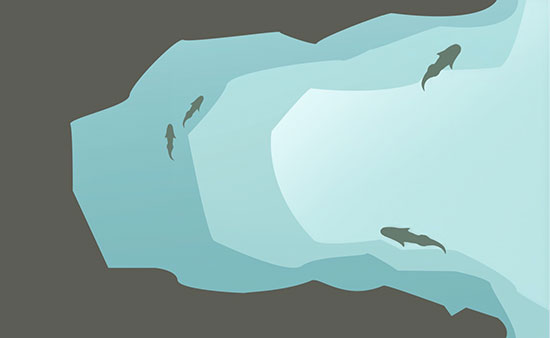
An inside turn is a small inlet that cuts into the shore and is one of the best fishing places. If the water in the turn is shallow, you've got another break line, and another great place to catch fish.
A cove is a larger version of an inside turn. With more shoreline, more shallows and more protection, and hopefully more fish. Smaller fish will patrol a cove for plant food and bait fish, and game fish may arrive early in the morning or late at night.
SHORELINE SHALLOWS
Water along the shore provides a lot of structure and food. So it attracts fish. Bait fish come in for the plant food. Pan fish, such as crappies, sunfish, bluegill and perch, come in for the bait fish. Early in the morning – or late at night - game fish will swim into the shallows to sneak up on both the bait fish and the pan fish. Yup, it's possible to land a big pike or even a muskie close to shore.
INLETS AND OUTLETS

All natural lakes are fed by a river or a stream of some sort. So they have inlets and outlets for the water. Wherever there is incoming or outgoing water, there's going to be a lot of food, and a lot of fish.
WALKWAYS AND BRIDGES
Walkways are like piers, but are specially built fishing platforms that are near or run parallel to bridges, piers, shoreline bulkheads, or similar structures. An example is a walkway along a bridge, but constructed at a lower level. This keeps anglers safe from auto traffic and puts them closer to the water.
Lake and pond fishing isn't always allowed from bridges because of the danger from traffic. Bridges where angling is permitted must be fished carefully.
RIPPLES, CURRENTS, SWIRLS AND SPRAYS
Call it what you will, but it might be a fish. It might be baitfish feeding. It might be baitfish trying to jump out of the water to escape game fish. Or, it might be bubbles and rings from a big fish that just went down to eat a minnow. Cast quickly, and you might get lucky.
Streams & Rivers
River fishing and stream fishing means knowing where the water is moving, and how fish behave in it.
NIGHT FISHING
Many fish are nocturnal feeders and become more active after the sun sets. When fishing during the night hours, natural baits, such as cut bait and live bait are great choices. Be sure to let the baits soak, and be patient for a bite.
ROILY WATER
Roily water is anywhere where currents work against jagged or eroded shorelines, such that the water becomes muddy or sediment filled. Turbulent, agitated or swirling water not only stirs up sediment but food as well, and such waters can be productive for finding fish. Fish around the edges of these areas.
SNAGGING
Snagging is a method of fishing that uses a heavy duty treble hook with a heavy lead weight embedded around the shank of the treble hook. The weighted hook is paired with a larger reel, heavy line in the 30-50 lb class, and a stout, sturdy rod which is typically 6 ft or longer. Anglers will cast the weighted treble hook out into the water, without any bait, and rapidly retrieve the hook hoping to ‘snag’ a fish. When a fish is snagged, the hook often finds itself lodged places other than the mouth of the fish. Because the angler hasn’t hooked the fish in the mouth, it is very difficult to turn the head of the fish towards the shore or boat as in traditional angling methods. The resulting fight with the fish is often much more difficult for the anglers which is why much heavier tackle is required. Many states have seasonal limits on snagging because it is often used to curb troublesome species of fish such as carp. Other states have banned this method completely so it is absolutely necessary for any angler to check their State’s rules and regulations about snagging before attempting.
STREAM AND RIVER FISHING
River fish find hiding places and travel anywhere from a few feet to up to several hundred feet, several times a day to eat. When stream or river fishing you have to decide if you're going to fish where the fish are hiding or where the fish are feeding. Either way, you'll have to understand how river fish feed and hide.
River fish hide in undercuts in the banks, eddies, sunken trees and overhanging trees and bushes. Places that provide protection from the current and above-water predators. Feeding places include the outside of bends, merging currents, drop-offs, feeder brooks and springs - places where the current slows and food collects or sinks.
In general, fish found in moving water tend to be a little smaller than lake fish. But they're fighters, strong from battling the currents.
OUTSIDE BENDS

When the river or stream curves, the faster water (which carries the food) moves to the outside of the bend. Fish look for food in these bends. And if the outside of the bend also contains a rock or fallen tree (to slow down the food-carrying current), it's an even better place to catch fish.
ROCK AND BOULDER POCKETS
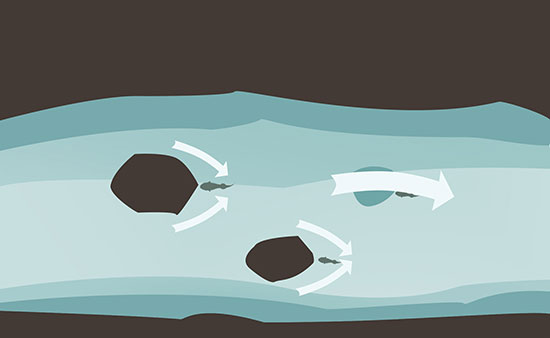
When flowing water hits rocks and boulders, it splits and goes around the obstruction, creating an area of calm water on the downstream side of the obstruction. Fish will rest, facing upstream, on the downstream side of a rock. These pockets are small, but a handy cast could land you a fish.
EDDIES

When fast moving water flows into a small inlet, or eddy, it slows down and creates a whirlpool. Fish will feed where the whirlpool is slowest, or in the main body of the river where the whirlpool kicks out the food that has been carried in and out of the eddy.
SMALL POINTED WAVES

These triangle-shaped waves form where faster water meets slower water like the riverside edge of a bend, bay or eddy. Large fish gather under these waves because the water slows and food drops.
MERGING CURRENTS - FEEDER BROOKS, STREAM OR CREEK MOUTHS

Flowing water carries food. So when two bodies of flowing water meet, fish will find even more food, making it an ideal river fishing spot. Plus, when currents collide, there's a small area in the intersection where the water and food actually slow down, making merging currents an excellent place to catch fish.
CURRENT EDGES
A current edge is a place where natural or man-made objects slow the current. When the current slows, the food that travels with it also slows. So river fish rest at current edges and wait for a nice, slow meal to come by. Current edges can be created by natural or man-made structures like bends, merging currents, drop-offs, rocks and islands.
DROP-OFFS

When water flows over a drop-off, it slows down and sinks, taking the food it carries with it. A drop-off is a great river fishing spot because it has food, deeper water and it's away from the current, allowing for a more relaxing dining experience for the fish.
OVERHANGING TREES AND BUSHES

Usually close to shore, these spots offer protection from the sun and above-water predators. Bigger fish will rest in these areas if the water isn't too shallow and allows quick access to deeper water for feeding and escape.
UNDERCUTS

Undercuts are considered the perfect hiding spot on the river. They occur where the current has cut a cave-like hole in earth or rock along the shore. If there's a tree above the undercut, all the better. Undercuts provide protection from above-water predators and the sun and easy access to deeper water for feeding or escape. The biggest river fish live in undercuts.
DAMS AND FALLS

When water continually drops off a dam or falls, it creates a big hole or drop-off. Fish will sit at the bottom of these holes to get away from the current and to eat sinking food. Fish can get trapped in these holes if they are going upstream to find cooler water or to spawn.
SPRING HOLES

When water boils up from the bottom of the river or stream, it creates a spring hole. Fish are attracted to these holes because the water coming up is cooler and the hole creates a place for food to sink.
STANDING WAVES
If you see waves on the water that look like a rollercoaster, the water is probably going over underwater rocks. Rainbow trout, for some reason, like to sit in the shallow part of these waves.
RIPARIAN ZONES
Riparian zones are the middle strip of vegetation between the river and the flatter land beyond the shore. These zones serve as a natural bio-filter to protect water from excessive sedimentation, polluted surface runoff and erosion. And they supply shelter, food and shade for fish and other aquatic animals. A thriving riparian zone is a sign of good water quality and good fishing.
Reservoirs & Flowages
When planning a flowage or reservoir fishing trip, you will need to find out if a reservoir fishing permit is required for the waterway you intend to use. Learn more about reservoirs and flowages in this section.
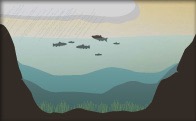
FLOWAGE AND RESERVOIR FISHING
Most reservoirs and flowages have been formed by the addition of a dam to a riverbed or creek bed. Since fish are most often found in areas of structure or where there is a change in water depth, topographic maps or video sonar of the terrain are useful when trying to determine where to fish in these types of waterways.
RESERVOIR GAME FISH SPECIES
A variety of freshwater game fish species can be targeted when on a reservoir fishing trip. Reservoir fishing for trout, such as rainbow trout and brown trout, is an ideal activity for families and beginning anglers since trout are usually eager to bite regardless of whether live bait or lures are being used. Largemouth bass, smallmouth bass, bluegill, crappie and perch are other game fish species that are often found in reservoirs or flowages. Be sure to check the state's fishing regulations to see which species are legal to catch based on the time of year and waterway.
RESERVOIR FISHING TIPS AND TRICKS
There are different types of fishing techniques that you can use when reservoir fishing. The type of technique will usually depend on the species of fish you are targeting, but there are some general tips and tricks that you can keep in mind when fishing a reservoir or flowage
①Check your state fishing regulations to see if a reservoir fishing permit is required to fish a specific waterway or to fish for a particular species.
②When deciding on the reservoir you want to start with, do a bit of research to determine which has the most structure and fish habitat. Look for drop-offs, islands, peninsulas, weed beds, inlets, shoals and rock piles.
③Find the areas within the reservoir that contain structure using a topographic map or sonar and fish those areas thoroughly.
④If you are fishing an older waterway, concentrate on docks and piers that are closer to shore. Largemouth bass will often move to shallower waters when deeper structure deteriorates or if holes and ledges cover with silt.
⑤When reservoir water levels drop, during the drier months of the year, focus your fishing efforts on the creek channels.
⑥Fish brush, weeds and points close to the shoreline for crappie using small tube jigs.
⑦During the summer months, plan to fish early in the morning or in the evening when temperatures are cooler and the sunlight isn't as bright.


 45次浏览
45次浏览